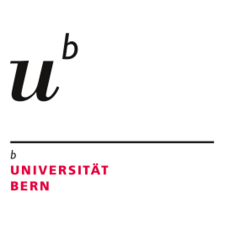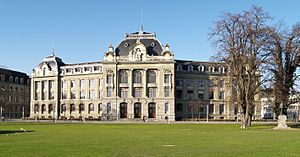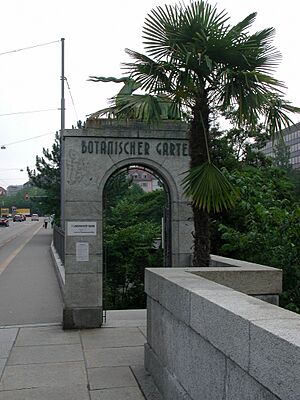University of Bern facts for kids
|
Universität Bern
|
|
 |
|
| Latin: Universitas Bernensis | |
| Type | Public (cantonal) |
|---|---|
| Established | 1834 |
| Budget | CHF 939 million (third-party funds: CHF 367 million) |
| Rector | Christian Leumann |
|
Academic staff
|
529 professors |
|
Administrative staff
|
1,874 |
| Students | 19,608 |
| Address |
Hochschulstrasse 6
,
,
,
3012
,
|
| Campus | Urban |
| Colours | White Red Blue |
| Affiliations | Guild of European Research-Intensive Universities, |
The University of Bern (in German: Universität Bern) is a public research university located in Bern, the capital city of Switzerland. It was founded in 1834 and is paid for by the canton of Bern (a canton is like a state in the U.S.).
The university is a large school with about 19,000 students, making it the third-largest university in Switzerland. It offers a wide variety of subjects to study, which are organized into eight main groups called faculties.
Contents
How the University is Organized
The University of Bern is run by a team that includes a leader called a rector, several vice-rectors, and an administrative director. They make important decisions for the university.
In 2024, the university had 19,608 students. Many were studying for their first degree (a bachelor's degree), while others were working on advanced degrees like master's or doctoral degrees. An interesting fact is that more women than men attend the university. In 2024, 60% of the students were women.
The table on the right shows how the number of students has grown over the years.
| Academic year | Students |
|---|---|
| 2014/2015 | 17,428 |
| 2015/2016 | 17,430 |
| 2016/2017 | 17,514 |
| 2017/2018 | 17,882 |
| 2018/2019 | 18,019 |
| 2019/2020 | 18,576 |
| 2020/2021 | 19,230 |
| 2021/2022 | 19,441 |
| 2022/2023 | 19,297 |
| 2023/2024 | 19,640 |
| 2024/2025 | 19,608 |
Location in the City
Instead of having one big campus outside the city, the University of Bern's buildings are spread throughout the city itself. Most of the buildings are in a neighborhood called Länggasse, which is right next to the city center. This means students can easily walk between their classes.
Some university buildings have a cool history. For example, the Faculty of Theology and some humanities classes are held in an old chocolate factory! Another building, which used to be a women's hospital, is now a center for law and economics students.
History of the University
How It All Started (1500s–1834)
The university's story begins in the 1500s. After the Reformation (a major change in the Christian church), a school was needed to train new pastors. In 1805, this school became an academy with four faculties, or subject areas. Students could then study not only religion but also law and medicine.
A New University (1834–1900)
In 1834, the government of Bern officially turned the academy into a university. It started with 45 professors and 167 students. The university grew peacefully and by 1900, it had 1,000 students, making it the largest in Switzerland at the time.
Many students came from other countries, especially Germany and Russia. In the 1870s, female students from Russia successfully fought for the right for women to study at the university.
A New Century (1900–1950)
As Bern grew, so did the university. In 1903, a new main building was opened. The university became famous thanks to three important people:
- Albert Einstein, the world-famous scientist, taught physics here in 1908.
- Anna Tumarkin, a Russian philosopher, became the first female professor in Europe who could grade doctoral students in 1909.
- Theodor Kocher, a surgeon from Bern, won the Nobel Prize in Medicine in 1909.
The Modern University (1950–Today)
After World War II, the university grew very quickly. By 1968, it had 5,000 students, and by 1992, it had 10,000. In 1996, the university became more independent from the government.
Today, the university follows the Bologna Process, which is a system used across Europe that structures degrees into bachelor's and master's programs. The university also focuses on important research areas, like climate change, and works with other universities.
What You Can Study
Faculties
A faculty is a department within a university that is dedicated to a specific area of study. The University of Bern has eight faculties:
- Theology (the study of religion)
- Law
- Business, Economics and Social Sciences
- Medicine
- Veterinary Medicine (for animal doctors)
- Humanities (subjects like history, languages, and art)
- Science (like biology, chemistry, and physics)
- Human Sciences (subjects like education and psychology)
Academic Programs
The university offers many different courses. Its Physics Institute is famous for helping with the first mission to the Moon. It still works with NASA and the ESA on space missions today.
Besides traditional subjects, the university also offers newer programs like sports science and theatre studies. It's the only university in Switzerland where students can specialize in dance.
Special Research Centers
The university has special centers that focus on important research topics. These centers bring together experts from different fields to solve big challenges. Some of the most important centers are:
- Oeschger Centre for Climate Change Research (OCCR): This center is a world leader in studying climate change. Its scientists have helped write major reports on the topic.
- Center for Space and Habitability (CSH): This center studies planets outside our solar system. It led a European project to launch a space telescope called CHEOPS.
- ARTORG Center for Biomedical Engineering Research: This center works on developing new medical technology, like artificial organs.
- World Trade Institute (WTI): This institute focuses on rules for the global economy and how to make the world more sustainable.
University Rankings
| University rankings | |
|---|---|
| Global – Overall | |
| ARWU World | 101–150 (2024) |
| QS World | =184 (2026) |
| THE World | =116 (2024) |
| USNWR Global | 111 (2024-25) |
University rankings compare schools from all over the world. The University of Bern is consistently ranked as one of the best. In 2023, the Times Higher Education World University Rankings placed it 94th in the world. The QS World University Rankings placed it 120th. This shows that it is a highly respected university.
Famous People from the University
Many famous and important people have taught or studied at the University of Bern.
Famous Teachers
- Albert Einstein: One of the most famous scientists in history.
- Anna Tumarkin: The first female professor in Europe with the power to examine doctoral students.
- Emil Theodor Kocher: A surgeon who won the Nobel Prize.
- Hans Oeschger: A physicist whose work on ice cores was very important for climate research.
Famous Students
- John le Carré: A famous author of spy novels.
- Friedrich Dürrenmatt: A well-known Swiss writer.
- Charles Albert Gobat: Winner of the Nobel Peace Prize in 1902.
- Thomas Jordan: The chairman of the Swiss National Bank.
- Kurt Wüthrich: A chemist who won the Nobel Prize in Chemistry in 2002.
- Thomas Zurbuchen: An astrophysicist who became a high-level administrator at NASA.
- Daniel Vasella: Former chairman and CEO of Novartis, a major healthcare company.
See also
 In Spanish: Universidad de Berna para niños
In Spanish: Universidad de Berna para niños
- List of largest universities by enrollment in Switzerland
- List of modern universities in Europe (1801–1945)
- List of universities in Switzerland





